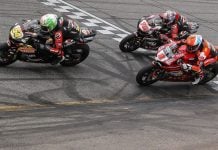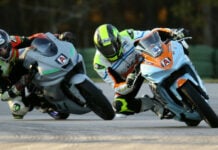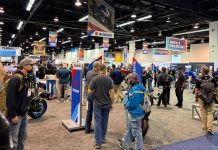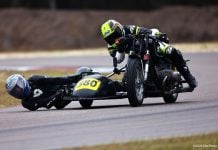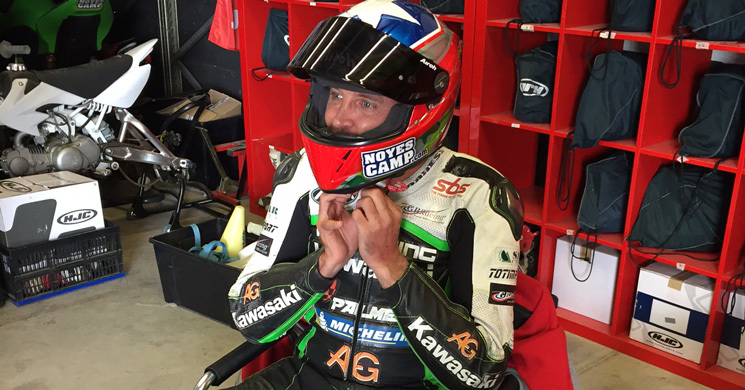Kenny Noyes: Smiling Again One Year Later
Kenny is sitting on his quad, smiling and chatting with his dad during the Noyes Camp Racing School session at Motorland Aragon just two days before the first anniversary of the life-threatening crash that happened on the GP roadrace track at this very circuit complex, and by the way they are joking and laughing you might think years had passed instead of just one.
Back on July 5, 2015, the reigning FIM CEV Repsol Champion had had a difficult two days of practice and the team had worked all night, but it seemed the problems were solved when Kenny went out for his Sunday morning warm-up. On his first flying lap he set the fastest sector times but then crashed. The bike bounced off the wall and came back and there was direct impact between the bike and Kenny´s helmet.
Now, at the end of a very hard year, Kenny is walking again, driving a car and, of course, riding bikes again. His family know that without the fast and efficient work of the Motorland Aragon Medical team, Kenny would not have survived. Thanks to them and to all that came after, his goals today are ambitious and on the horizon.
The crash and the first days and weeks
Kenny arrived by emergency medical helicopter at the University Hospital Clinic in Zaragoza, eighty miles north of the circuit, in a stage Glasgow-3 coma, the most critical level on the established Coma Scale: no reaction to any stimulus. He was on life-support for breathing, hydration and nutrition and the first 24 hours were the most critical. His skull was drilled to place a pressure relief tube and he was kept under induced coma.
The first evaluation of the medical team was that the family should be prepared for the worst. The first good news came the following morning when Dr. Pilar Luque confirmed that the cerebral hemorrhage had not grown and was capsulating. Her cautious words were, “The situation is better than we expected.”
She explained that with this type of injury and recuperation there are no reliable predictions of outcomes or recovery time. Nearly a month after the accident the situation remained worryingly stable and the family was warned that Kenny might remain in a vegetative state. After that the family, Kenny´s wife Iana, Denny, his younger brother and his parents, Heidi and Dennis, decided on a “super intensive” program of sensory stimulation. Exceptions were made to hospital rules and the family was given permission for virtually unlimited visits of two persons at a time. The “team” organized into shifts and after a single weekend of intense stimulation, Kenny opened his eyes voluntarily for the first time.
The family´s key role in recovery
Now, with Kenny making steady improvement, the family firmly believes that almost constant accompaniment and stimulation, allowing for periods or rest of course, is vital to the recovery of a person in a situation like Kenny´s.
“You just have to remain positive and reject all negativity,” says Dennis. Dennis told Kenny racing stories and when he told Kenny a familiar story about Kenny Roberts and Randy Mamola, “Kenny made eye contact”. Dennis even read aloud for hours and retold stories from Kenny´s childhood as did Heidi who also sang songs. Wife Iana and younger brother Denny were the ones who provided the more aggressive stimuli…they pinched him, pulled his hair and Iana even bit him. They exhorted him to wake up, to open his eyes, to fight back. “Heidi and I were the good cops, Iana and Denny the bad ones,” Dennis says.
Dennis, a journalist and writer, kept a daily log of events and the teams shared their experiences so that it was all kept in diary form in order to keep the doctor informed and establish that he was able to follow instructions, proof that he was moving from deep coma into a state called “minimal consciousness” which is recognized by specialists when a person is able to follow simple commands like “squeeze my hand,” or “open the throttle with your throttle hand.”
The work went on for days: old friends from Miraflores sent recordings of recapitulations of adventures in the Guadarrama mountains, the childhood playground of Kenny and his friends. His wife annoyed him by ticking his face with her hair, something that he had always hated. When he got mad, that was big progress.
One day Dennis handed Kenny, who had been a pitcher, a baseball and asked him to throw a curve. Kenny´s hand “remembered” the grip for a curve. ”The feeling of a familiar object, like a baseball, seemed to stimulate memories,” Dennis observed.
During this first stage of recuperation, says Iana, “the nurses play a key role along with the family because they are the ones who are with the patient the most.”
After several days on this “intensive stimulation,” Dr. Luque of the Zaragoza hospital decided the time had come to move Kenny into the Guttmann Institute in Barcelona, two hundred miles east, where the emphasis gradually shifted from stabilization to recovery and rehabilitation.
Denny, Kenny´s brother, advises others who might find themselves in the same situation that in order to ensure that the recovery goes well they must also take care of themselves. “If you want to help,” he says, “you have to get enough rest and stay active. Ask the nurses what you can do to help but also ask other families in the ward who are going through the same process with a loved one. And, when you have time, read up on the type of injury and how it is treated and what to expect, but don´t accept limits.”
The next phases of recuperation took place in the Guttmann Institute and the StepByStep Foundation in Barcelona, both specialized centers in medullary (spinal) and brain injuries. The Guttmann Institute is a fully-equipped and staffed specialized hospital and StebByStep concentrates on more aggressive physical rehabilitation Kenny attends daily sessions at both with the same goal in mind…to get back on the Palmeto Kawasaki ZX-10R, but only if and when he is ready.
Specialists also point out that it is vital that the patient has the will, the drive, to work hard. Machines help but the patient determines how much. Kenny´s years as a disciplined road racer, solving problems, testing limits and constantly improving have contributed to his rate of recovery.
When Kenny entered the Guttmann at the beginning of August it was a critical time and his short daily specialist rehab was supplemented by the family.
“Nobody knows the patient like the family,” says Iana “and you need to know your loved ones limits and then push those limits more than most doctors would advise. The doctors are always conservative, but the family often knows best.” An anecdote to demonstrate this: Eight months after the accident Iana believed Kenny was ready to try his hand at a driving/riding simulator, but the doctors felt it was too soon. However, the very next weekend Iana and Denny took Kenny to the Noyes Camp at Motorland where he himself demanded to climb on a 1000cc Suzuki mounted on a “wheelie machine” and that same weekend he was encouraged to drive a car at the circuit and also to ride a motorcycle, drive a tractor to water the track and operate heavy earth-moving equipment for track maintenance. It couldn´t have been better for his recovery. Soon afterward he was reclassified as an out-patient.
Sixteen-year-old Kenny
But before he was able to leave the Guttmann, Kenny went through a period of recovering his memory. For a while he thought he was sixteen years old and refused to believe that Denny was his brother. As Denny tells it, “My sixteen-year-old big brother refused to believe his little brother had a beard.”
At that point Kenny was experiencing post traumatic amnesia and the family had to constantly remind him where he was and why. Iana explained over and over the crash with all details and aftermath. He was shown photo albums and videos and these were indispensable tools that brought him into real time and filled in holes in his memory. Doctors and nurses finally determined he had gone beyond post traumatic amnesia, a big step in recovery from coma, when he was able to remember their names and faces and when he was oriented in time and place and knew what had happened on July 5th at Motorland. He will probably never, doctors say, remember the crash, but there are continual improvements in short and long term memory.
Seven months after the crash he was oriented in time and place, but brother Denny observes, “To recover, the person needs to believe in his own recovery, want it and work hard for it every day.” Dennis had to return periodically to the Grand Prix paddock to do his job as a TV commentator for Spain´s Tele5 and, because of periods of absence, he was the one who most clearly saw the improvements.
The first smile
The family observed as Kenny moved up the Glasgow coma scale from the dreaded level of Glasgow 3 all the way to to the top (15. There were long, troubled times of bad news and no apparent improvement but there came a day when Kenny smiled again. It was his brother who produced that smile, singing and dancing in the hospital room at the Guttmann Institute, a moment that the family will always remember in the form of a video, but Denny sums it up best: “It´s the best thing I´ve done in my life, coming up with a dance that made my brother smile.”
On the 5th of July, 2015, Kenny Noyes´s was evacuated by helicopter after his terrible crash at Motorland Aragon (Spain). Now, a year later to the day, he is able to joke with riders taking part in a two-day session at his Noyes Camp Racing School, after a long and continuing recovery period that included competing with his brother flying remote control helicopters in his hospital room and landing them for points in chalk-marked squares on the floor. Whether it is on the race track with his 1000cc Kawasaki Superbike or slotting toy helicopters into landing pads in his hospital room, Kenny is as competitive as ever, like the Spanish Superbike Champion that he is.
Kenny Noyes One Year after the Accident: “I still love racing”
The last time I interviewed Kenny Noyes, he was preparing for the season that would see him win the FIM CEV International Superbike Championship in Spain. Now, two and a half years later all has changed in ways that seemed unimaginable when Kenny and I last spoke in Elche (Alicante).
Today, July 5, is exactly one year after the accident he suffered during Sunday morning warm up at the Motorland circuit in Aragon. Kenny arrived in deep coma by medevac helicopter in Zaragoza with severe cranioencephalic trauma, skull fracture, brain injury and maxillofacial fractures. The excellent work by the Motorland medical team and intense work at the University Hospital Clinic of Zaragoza plus the daily support by his immediate family have made it possible for Kenny to walk again, to joke just as he used to and even to begin to ride again and to work toward the goal that we can can imagine. At present he directs the Kawasaki Noyes Camp Racing School and is intensely involved in the Spanish National RFME Flat Track Championship, but behind all this activity is the desire to race again. “My real job is racing.”
Question: What is it about motorcycle Racing that, in spite of the accident, makes you want to get back on the bikes?
Kenny Noyes: I can´t put it in words, but for me there is something there that drives me. I don´t know what it is, but it´s powerful.
Q: What did you feel the day you put your leathers on again and went back out on a Dirt tracker?
KN: What I felt was slow. The leathers, boots and helmet were all heavier that I remembered. It was strange but it was so cool to back back on the bike.
Q: Nervous?
Q: I don´t know. I just thought I´d be faster, but its normal considering where I am in my recovery.
(At this moment Kenny´s wife, Iana, spoke up: “He was smiling from ear to ear and then he got mad because he said he was too slow.”)
Q: Who have been the people who most supported you through all this?
KN: My family. Their presence helped so much because it can be rough in the hospital. Without my brother, my wife and my folks it would have been really hard.
Q: Did you feel the support of fans from the #FuerzaKennyNoyes hashtag?
KN: I read all the tweets, looked at all the hashtags references, although it wasn´t until seven months after the accident when I was able. All that helped a lot and helps me now as I recover. The folks from my town of Miraflores de la Sierra in the mountains north of Madrid got together and made a video, they sent photos and messages encouraging me to work to recover.
(Iana added that this support was also important to the family in the hardest times.)
Q: What was the hardest moment during recovery?
KN: The beginning when I came fully out of the coma, I didn´t know what had happened. I thought I was a lot better than I was and that this was all something the doctors were making up and if they would let me race I´d be fine. The most difficult was getting my mind around reality.
Q: Before the accident, had you ever thought much about the risks of this sport?
KN: I never thought much about it and I still don´t. Risk is part of our sport. In the Guttmann Institute I have seen a lot of people in very bad shape because of an accident on the way to work. I was lucky that my crash was on a race track in a controlled environment and that I was doing what I love.
Q: You have been doing six hours a day of rehab. Where does the strength for that come from?
KN: Now that my rehab is much more physical it tires me more. Before I was working six hours a day from a wheel chair, but now I am out of the chair and on a schedule more like what I used to do in the gym. I go to Guttmann, to StepByStep and to ReSport. The first two are specialized in my type of injury and the third is a rehab center for recovering athletes. I now put in three hours a day plus what I do on my own at home.
Q: Do you feel that what you have accomplished in your career compensates for all that has happened this last year?
KN: Yeah, but I don´t want my career to end this way. I´d like to be the one to decide when to stop. It´s hard to answer “yes” to that question. It compensates some, but not completely. I really don´t know.
Q: What it the most frustrating thing about your current state of recovery?
KN: Lack of balance for walking. I´ve got speaking difficulty too. My brain is faster that my mouth. For now, I prefer to listen rather than talk. The doctors say the recuperation is very good but it feels too slow to me. The hardest thing is not being able to ride fast like I did before. Not yet.
Q: What is your best memory of the racing?
KN: Winning championships. Winning races. Working with my team. My objectives were realistic and I achieved them. In the World Championship I wanted to achieve some good results and I did, but the two championships I really wanted to win were the Pro Singles Championship back in 2000 and the Spanish Superbike title in 2014 and I accomplished those goals.
Q: And in the World Championship?
KN: I had some good rides, good finishes. I started on the pole in Le Mans and I especially remember finished fifth in the rain on slicks at the GP of Valencia en 20110.
Q: And the Spanish National Championship (CEV)?
KN: Sure, I remember all the poles and podiums and wins. It was a good atmosphere, close, intense. And I especially remember the good times with my team, Palmeto Racing, and all the races and practices we did over the years.
Q: What is your recovery goal?
KN: I want to be like I was before to the extent that that is possible. I want to race, but we´ll have to see.
Q: Do you see yourself continuing to direct the Kawasaki Noyes Camp Racing School and working in the organization of the Spanish Flat Track Championship?
KN: Yes, but I don´t see that as my main work. My job is to race. I see everything from the perspective of a racer.
KN: How do you see this season developing for your flat track team?
KN: My riders, Ferry Sastre, Alejandro Ros and Ferran Mas, are going well. We have a solid team. It´s kinda hard to see someone else riding my bike though. The good part is that we´ve got a load of bikes and, when I´m ready, I can start playing with the KLX140s and if they seem fast then I´ll know I´m not ready yet. Then come the 450s and finally the Superbike with PL Racing. They´re holding my seat for me. I´m really glad I won that CEV Superbike title on the last day of the season because if I hadn´t, I´d be regretting that now. My idea was to defend that title a few more times and retire when I felt ready, but my crash hasn´t changed a bit the way I feel about racing. I still love racing.
After this interview I spoke to Kenny´s father, Dennis Noyes, one of Spain´s top motorcycle journalists and TV commentators. Here are some excerpts:
Q: After this difficult year, what have you learned that might by useful for family members of someone who has suffered an accident like Kenny´s?
DN: Dr. Luque in the Intensive Care Unit at Zaragoza told us that many times the family members are so devastated that they just stand back and leave everything in the hands of the medical staff, but that the family has a vital role to be with the injured person who is confused, barely aware and alone. The voice and touch of a loved one reach into the coma in ways that the best treatment can´t.
We thank God we are seeing Kenny recover and the advice that I´d give to any family members who are experiencing what we have is that they should not accept a negative prognosis, they should not resign themselves. They should stay close, touching, talking, stimulating so that the injured person will know that he/she is not alone and to help the person retain a sense of connection and to know that the world is still out there waiting for their return.
Q: What messages of encouragement do you most remember?
DN: There were so many, hundreds. I especially remember Wayne Rainey calling often, and Angel Nieto. Wayne told me about Bubba Shobert´s recovery and Angel also shared stories of friends of his who had pulled through, because the first medical reports when Kenny was flown out to Zaragoza were very bad. I don´t remember so much what they said, but I remember they told us to be patient and to keep faith.
But the one call I most remember came when Kenny was still in deep coma only days after the crash. I had just heard the day before of the death of two rivals and friends of Kenny´s, Bernat Marínez and Dani Rivas at the start of the MotoAmerica Superbike race at Laguna Seca. The call came from Dani Rivas´s father, Willy Rivas, who thought of us so soon after the death of his own son. He said, “I´ve lost my boy but you are not going to lose yours because there just can´t be so much misfortune in so short a time. Believe me, your boy will make it. I know that!”


